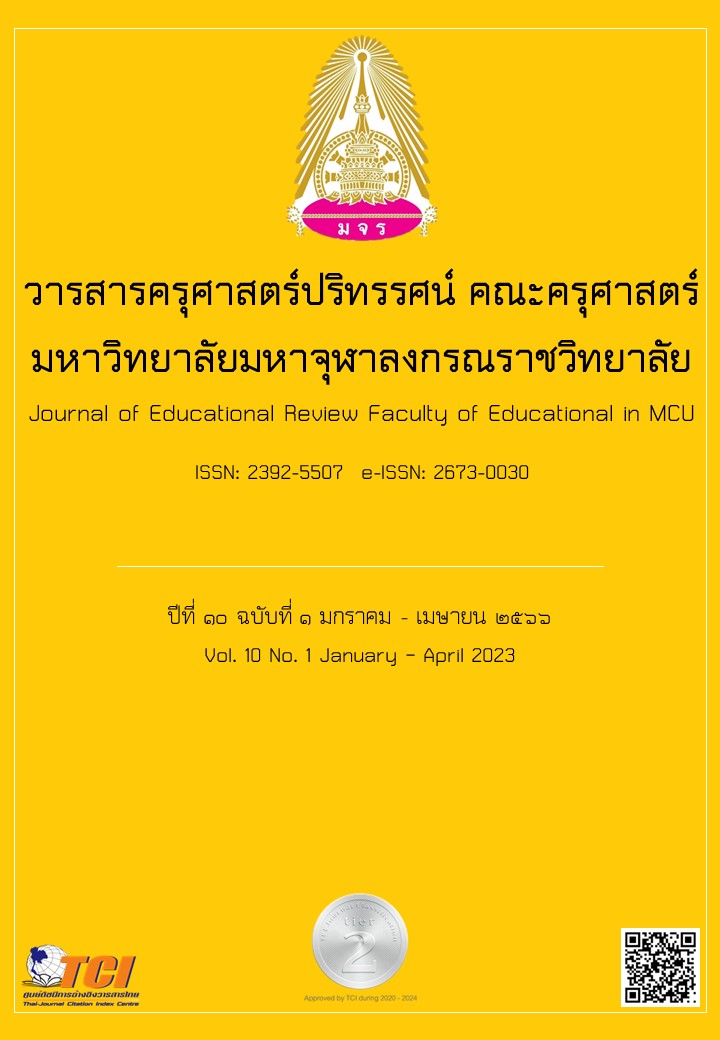DEVELOPMENT MODEL OF INTERNAL SUPERVISION UNDER LEARNING MANAGEMENT BASED ON STEM EDUCATION IN SCHOOL AFFLIATED WITH BANGKOK METROPOLITAN ADMINISTRATION
Main Article Content
Abstract
This research paper aims to develop and evaluate model of internal supervision under learning management based on STEM Education in schools affiliated with Bangkok Metropolitan Administration. There was divided into three steps; Step 1: Study condition and guidelines the model of internal supervision under learning management based on STEM Education in schools affiliated with Bangkok Metropolitan Administration. Step 2: Development and validation the model of internal supervision under learning management based on STEM Education in schools affiliated with Bangkok Metropolitan Administration. Step 3: Try out and evaluate the model of internal supervision under learning management based on STEM Education in schools affiliated with Bangkok Metropolitan Administration. Sample was 132 people with purposive sampling, they consisted of school directors, deputy directors for academic affairs, heads of science, mathematics and technology department from learning management based on STEM Education Center’s schools affiliated with Bangkok Metropolitan Administration. To be interviewed 6 experts, they consisted of 1) school directors 2) education supervisors 3) lecturers in higher education institution. The research instrument was questionnaire, interview, evaluate feasibility and benefit. It was analyzed using basic statistics and content analysis. The results revealed that status of internal supervision under learning management based on STEM Education in schools affiliated with Bangkok Metropolitan Administration in overall, performance was at high level. The result of model development consisted of 2 components. Component 1 was model learning management based on STEM Education in schools affiliated with Bangkok Metropolitan Administration, there were 6 steps, such as 1) Problem Identification 2) Related Information Search 3) Solution Design 4) Planning and Development 5) Testing, Evaluation, and Design improvement 6) Presentation. Component 2 was a procedure of internal supervision in schools such as 1) Studying Problem Conditions and Teacher’s Need 2) Educational Supervision Planning 3) Supervision Performance 4) Supervision Evaluation. The result of evaluate feasibility and benefit was at high level.
Article Details

This work is licensed under a Creative Commons Attribution-NonCommercial-NoDerivatives 4.0 International License.
ทัศนะและความคิดเห็นที่ปรากฏในบทความในวารสารฉบับนี้ถือเป็นความรับผิดชอบของผู้เขียนบทความนั้นเพียงผู้เดียว และไม่ถือเป็นทัศนะและความรับผิดชอบของกองบรรณาธิการ
กองบรรณาธิการขอสงวนสิทธิ์ในการคัดเลือกบทความลงตีพิมพ์และจะแจ้งให้เจ้าของบทความทราบหลังจากผู้ประเมินบทความตรวจอ่านบทความแล้ว
ต้นฉบับที่ได้รับการตีพิมพ์ในวารสารครุศาสตร์ปริทรรศน์ คณะครุศาสตร์ มหาวิทยาลัยมหาจุฬาลงกรณราชวิทยาลัย ถือเป็นกรรมสิทธิ์ของคณะครุศาสตร์ มหาวิทยาลัยมหาจุฬาลงกรณราชวิทยาลัย ห้ามนำข้อความทั้งหมดหรือบางส่วนไปพิมพ์ซ้ำ เว้นเสียแต่ว่าจะได้รับอนุญาตจากมหาวิทยาลัยฯ เป็นลายลักษณ์อักษร
References
เกรียงศักดิ์ สังข์ไชย. (2552). การพัฒนารูปแบบการนิเทศการสอนครูวิทยาศาสตร์เพื่อพัฒนาศักยภาพนักเรียนที่มีแววความสามารถพิเศษทางวิทยาศาสตร์. ดุษฎีนิพนธ์ปรัชญาดุษฎีบัณฑิต. มหาวิทยาลัยศิลปากร.
ชญากาญจธ์ ศรีเนตร. (2558). รูปแบบการนิเทศภายในสถานศึกษาสังกัดสำนักงานเขตพื้นที่การศึกษามัธยมศึกษาเขต 25. วิทยานิพนธ์ครุศาสตรมหาบัณฑิต. มหาวิทยาลัยมหาสารคาม.
ดวงพร สมจันทร์ตา. (2559). การพัฒนาความสามารถในการแก้ปัญหาทางวิทยาศาสตร์ของนักเรียนระดับชั้นมัธยมศึกษาตอนปลายที่ได้รับการเรียนตามแนวทางสะเต็มศึกษา เรื่อง กายวิภาคศาสตร์ของพืช. วิทยานิพนธ์การศึกษามหาบัณฑิต. มหาวิทยาลัยศรีนครินทรวิโรฒ.
นพพรพรรณ ญาณโกมุท. (2558). การพัฒนารูปแบบการนิเทศภายในตามแนวคิดการศึกษาชั้นเรียนสำหรับโรงเรียนเอกชน. ดุษฎีนิพนธ์ปรัชญาดุษฎีบัณฑิต. มหาวิทยาลัยราชภัฏนครสวรรค์.
พรทิพย์ ศิริภัทราชัย. (2559). STEM Education กับการพัฒนาทักษะในศตวรรษที่ 21. วารสารนักบริหาร มหาวิทยาลัยศรีนครินทรวิโรฒ. 33(2). 95-96.
พรพรรณ ไวทยางกูร. (2556). สะเต็มศึกษา: ก้าวสำคัญของการนำสะเต็มศึกษาไปใช้กับความหวัง ยกระดับคุณภาพศึกษาไทย. แหล่งที่มา http//www.daliynews.co.th/education. สืบค้นเมื่อ 20 พ.ย. 2565.
วิจารณ์ พานิช. (2555). วิถีสร้างการเรียนรู้เพื่อศิษย์ในศตวรรษที่ 21. กรุงเทพมหานคร: มูลนิธิสดศรี-สฤษดิ์วงศ์.
วิชัย วงษ์ใหญ่. (2554). นวัตกรรมหลักสูตรและการเรียนรู้สู่ความเป็นพลเมือง. กรุงเทพมหานคร: อาร์แอนด์ปริ้นท์.
สถาบันส่งเสริมการสอนวิทยาศาสตร์และเทคโนโลยี. (2551). ความรู้และสมรรถนะทางวิทยาศาสตร์สำหรับโลกวันพรุ่งนี้. กรุงเทพมหานคร: เซเวนกรุ๊ป.
สถาบันส่งเสริมการสอนวิทยาศาสตร์และเทคโนโลยี. (2553). ตัวอย่างข้อสอบที่ใช้ในการประเมินผลการเรียนรู้วิชาวิทยาศาสตร์. กรุงเทพมหานคร: แอดวานซ์ พริ้นติ้ง เซอร์วิส.
สถาบันส่งเสริมการสอนวิทยาศาสตร์และเทคโนโลยี. (2558). คู่มือจัดกิจกรรมสะเต็มศึกษา ระดับชั้นประถมศึกษา ปีที่ 1-3. กรุงเทพมหานคร: สถาบันส่งเสริมการสอนวิทยาศาสตร์และเทคโนโลยี.
สถาบันส่งเสริมการสอนวิทยาศาสตร์และเทคโนโลยี. (2561). ผลการประเมิน PISA 2015 บอกอะไรถึงระดับนโยบาย. แหล่งที่มา https://pisathailand.ipst.ac.th/issue-2017-14/ สืบค้นเมื่อ 20 พ.ย. 2564.
สำนักงานคณะกรรมการการศึกษาขั้นพื้นฐาน. (2562). แนวทางการนิเทศบูรณาการโดยใช้พื้นที่ เป็นฐานเพื่อพัฒนาคุณภาพการศึกษาสู่การนิเทศภายในโดยใช้ห้องเรียนเป็นฐาน. กรุงเทพมหานคร: โรงพิมพ์คุรุสภา.
สำนักงานเลขาธิการสภาการศึกษา. (2561). การบริหารงานวิชาการ. กรุงเทพมหานคร: สำนักงานเลขาธิการสภาการศึกษา.
อัญชลี โพธิ์ทอง. (2548). นิเทศการศึกษา. กรุงเทพมหานคร: สำนักพิมพ์มหาวิทยาลัยรามคำแหง.
อารมณ์ ฉนวนจิตร. (2556). นวัตกรรมนิเทศการจัดการเรียนรู้. กรุงเทพมหานคร: สำนักพิมพ์มหาวิทยาลัยรามคำแหง.
Krejcie, R. V., & Morgan, D. W. (1970). Determining sample size for research activities. Educational and Psychological Measurement. 30(3). 607–610.


